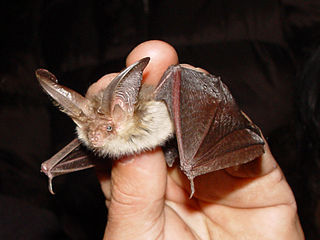
Vespertilionidae is a family of microbats, of the order Chiroptera, flying, insect-eating mammals variously described as the common, vesper, or simple nosed bats. The vespertilionid family is the most diverse and widely distributed of bat families, specialised in many forms to occupy a range of habitats and ecological circumstances, and it is frequently observed or the subject of research. The facial features of the species are often simple, as they mainly rely on vocally emitted echolocation. The tails of the species are enclosed by the lower flight membranes between the legs. Over 300 species are distributed all over the world, on every continent except Antarctica. It owes its name to the genus Vespertilio, which takes its name from a word for bat, vespertilio, derived from the Latin term vesper meaning 'evening'; they are termed "evening bats" and were once referred to as "evening birds".

Gould's long-eared bat is a microbat found in southern regions of Australia. It occurs in eastern Australia, from Queensland to Victoria, and in a smaller isolated range in the south-west of Western Australia.
Bobrinski's serotine is a species of vesper bat. It can be found in Iran and Kazakhstan.
Botta's serotine is a species of vesper bat, one of 25 in the genus Eptesicus. It is found in rocky areas and temperate desert.

The desert long-eared bat is a species of vesper bat found in North Africa and the Middle East.
The Ethiopian long-eared bat or Ethiopian big-eared bat is a species of long-eared bat in the family Vespertilionidae.
Christie's long-eared bat, also known as the Egyptian long-eared bat, Christie's big-eared bat, or gray long-eared bat, is a species of vesper bat in the family Vespertilionidae. It is known from North Africa and the Middle East. Its natural habitats are subtropical or tropical dry shrubland, rocky areas, and hot deserts.

The blunt-eared bat or Peruvian crevice-dwelling bat is a species of bat in the family Molossidae. It is monotypic within the genus Tomopeas and subfamily Tomopeatinae. It is endemic to Peru, where it is considered critically endangered. It is threatened by habitat loss.

The Vespertilioninae are a subfamily of vesper bats from the family Vespertilionidae.

Otonycteris is a genus of vesper bats. Members of this genus are found in Northern Africa and Central Asia. Until recently, it was thought to be monotypic, but in 2010, the Turkestani long-eared bat was distinguished from the desert long-eared bat; previously, all populations were recognized as the desert long-eared bat.

The Sardinian long-eared bat is a species of bat endemic to Sardinia, Italy.
The Yemeni mouse-tailed bat is an endangered species of bat found in Yemen. It is only known from one roost, and its population is estimated at 150 individuals.

Thomas's big-eared brown bat is a species of vesper bat found in South America.

The long-toothed pipistrelle is a species of bat of the genus Hypsugo. It is a small bat, with a length of 35.2–38.4 mm of forearm, and 5.9–7 mm of foot. It feeds on insects and has especially long canines compared to others of its genus.

The Tasmanian long-eared bat is a species of vesper bat endemic to Tasmania.

Nyctophilus major, referred to as a western long-eared bat, is a species found in forests and woodlands of Southwest Australia.

Plecotini is a tribe of bats in the family Vespertilionidae. It contains several genera found throughout the Northern Hemisphere, in Eurasia, North Africa, and North America. Several genera in this tribe are known as big-eared bats or long-eared bats. It also contains the spotted bat and barbastelles.
Kozlov's long-eared bat is a species of vesper bat in the family Vespertilionidae. It is found in southern Mongolia and adjacent parts of China.
Ward's long-eared bat is a species of vesper bat in the family Vespertilionidae. It is found in mountainous regions of South Asia and adjoining regions.










